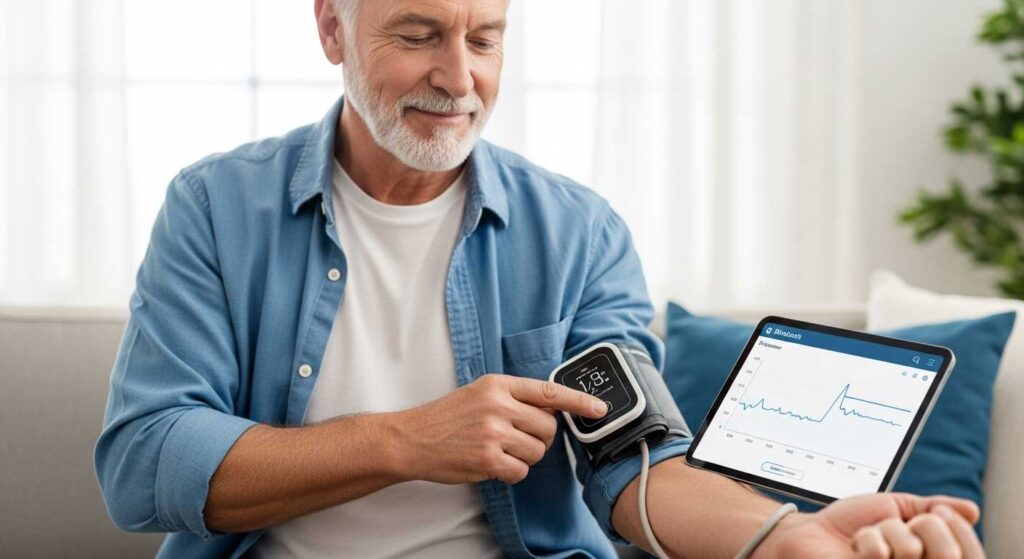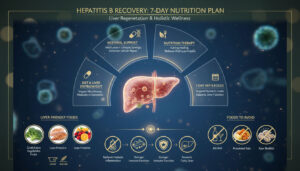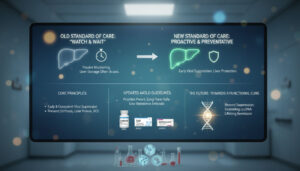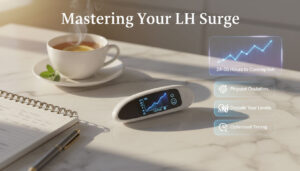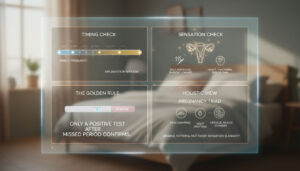In the United States, a quiet health crisis is unfolding daily. According to the Centers for Disease Control and Prevention (CDC), a staggering 6 in 10 adults live with at least one chronic disease, and 4 in 10 have two or more. These long-term conditions, such as diabetes, hypertension, and heart disease, are the primary drivers of the nation’s $4.1 trillion in annual healthcare costs. For millions, managing these conditions is a relentless challenge. However, a proactive, data-driven approach is changing the landscape of long-term care: chronic disease monitoring.
- What Exactly Is Chronic Disease Monitoring?
- The Technology Revolution: Remote Patient Monitoring (RPM) in Detail
- A Practical Guide to At-Home Health Monitoring
- The Role of Diagnostic Services: How HealthCareOnTime.com Simplifies Monitoring
- The Big Picture: Healthcare System Impact and Provider Roles
- The Future of Chronic Disease Monitoring
- Taking Control of Your Health Journey
- Frequently Asked Questions (FAQs)

This is not about reactive treatments or waiting for symptoms to worsen. It is about a fundamental shift toward continuous, informed self-management and collaborative care. By consistently tracking key health metrics, patients and their doctors can make timely, effective decisions that prevent complications, improve quality of life, and ultimately give individuals control over their health journey. This article will serve as your comprehensive guide, exploring the vital role of chronic disease monitoring, the powerful technology driving it, its practical applications, and how accessible services from HealthCareOnTime.com are empowering people to take charge of their well-being.
What Exactly Is Chronic Disease Monitoring?
At its core, chronic disease monitoring is the systematic, ongoing process of collecting and evaluating a patient’s health data to track the progression of a long-term condition and their response to treatment. It is a collaborative partnership between the patient and their healthcare provider, built on the foundation of consistent, reliable information.
A Proactive Approach to Long-Term Health
Instead of relying on infrequent office visits to get a snapshot of your health, this approach creates a continuous stream of information. This data provides a more complete picture of your health status over time, allowing for a much more nuanced and effective strategy for managing chronic diseases. It transforms healthcare from a series of isolated events into an ongoing, dynamic process.
The Primary Goals of Effective Monitoring

The purpose of diligent chronic disease monitoring extends far beyond simply collecting numbers. The ultimate objectives are to:
- Detect Complications Early: Consistent tracking can reveal subtle changes in your health metrics that signal a potential problem long before you feel symptoms, allowing for early intervention.
- Provide Data for Treatment Adjustments: The data collected helps your doctor see how well your current treatment plan is working and make precise adjustments to medications, diet, or lifestyle recommendations.
- Empower Patients with Information: When you can see the direct impact of your choices on your health data—like how a healthy meal affects your blood sugar—you become an empowered, active participant in your own care.
- Prevent Costly Emergencies: By catching issues early, monitoring helps prevent severe complications that could lead to expensive emergency room visits and hospitalizations, helping to reduce healthcare costs.
- Improve Overall Quality of Life: Effective managing of chronic diseases means fewer symptoms, more energy, and the freedom to live a fuller, more active life.
The Three Pillars of Modern Monitoring
Modern chronic disease monitoring stands on three essential pillars, each playing a unique role in building a complete health profile.

- In-Clinic Monitoring: This is the traditional foundation of care, including regular check-ups with your primary care physician, specialist appointments, and crucial laboratory tests that provide deep clinical insights.
- Self-Monitoring: This involves patient-led at-home health monitoring. Simple, consistent actions like daily weight checks for heart failure patients or routine blood pressure monitoring for those with hypertension form the bedrock of self-management.
- Remote Monitoring: This is the technological evolution of monitoring, using connected devices to automatically collect and transmit health data to providers, enabling a level of oversight that was previously impossible.
The Technology Revolution: Remote Patient Monitoring (RPM) in Detail
Technology has fundamentally reshaped our ability to manage long-term health, and Remote Patient Monitoring (RPM) is at the forefront of this transformation. As a specialized form of telehealth, RPM uses digital technologies to collect health data from individuals in one location and electronically transmit that information securely to healthcare providers in a different location for assessment and recommendations.
The process is remarkably simple yet powerful. A patient uses a medical device (like a blood pressure cuff or glucometer) at home. The device captures the reading and automatically sends it to a secure platform where the patient’s care team can review it. This creates a continuous feedback loop that keeps patients and providers connected.

The Tangible Benefits of RPM (Backed by Data)
The adoption of Remote Patient Monitoring (RPM) is not just about convenience; it delivers measurable improvements in health outcomes. Research from institutions like the University of Pittsburgh Medical Center (UPMC) has consistently shown that robust RPM programs can lead to significant reductions in hospital readmissions and emergency room visits. This proactive model allows clinicians to intervene before a health issue becomes a crisis. For patients, this means fewer hospital stays, better health stability, and a greater sense of security.
The Tools of the Trade: Common RPM and Wearable Health Devices
The ecosystem of at-home health monitoring technology is rapidly expanding. These devices are designed to be user-friendly, accurate, and seamlessly integrated into a patient’s daily routine.
Blood Pressure Cuffs
For the 120 million American adults with hypertension, regular blood pressure monitoring is critical. Modern Bluetooth-enabled cuffs from trusted brands like Omron automatically record and sync readings to a smartphone app or a provider’s dashboard, eliminating the need for manual logs and ensuring data is captured accurately.
Glucometers and Continuous Glucose Monitors (CGM)
Managing chronic diseases like diabetes requires diligent blood sugar tracking. While traditional glucometers provide a snapshot, Continuous Glucose Monitoring (CGM) systems like the Dexcom G6 or Abbott Freestyle Libre have been game-changers. A small sensor worn on the body tracks glucose levels 24/7, providing real-time data and alerts for high or low levels, which is a cornerstone of modern diabetes management.
Smart Scales and Pulse Oximeters
For individuals with heart failure, sudden weight gain can be an early sign of fluid retention, a serious complication. Smart scales (from brands like Withings) transmit daily weight readings to care teams, allowing for swift intervention. Similarly, pulse oximeters that measure blood oxygen levels are vital tools for the at-home health monitoring of respiratory conditions like COPD.
The Rise of Wearable Health Devices

Beyond medical-specific devices, mainstream wearable health devices are playing an increasingly important role. Smartwatches like the Apple Watch can take an ECG to detect signs of atrial fibrillation and measure blood oxygen levels. Fitness trackers from companies like Fitbit monitor activity levels, sleep patterns, and heart rate—all valuable data points that contribute to a holistic view of a person’s health.
A Practical Guide to At-Home Health Monitoring
Effective managing of chronic diseases begins at home. Taking an active role in at-home health monitoring is one of the most powerful things you can do to protect your health. This section provides an actionable guide to help you get started.
Best Practices for Accurate Self-Monitoring
Consistency and accuracy are key to meaningful self-monitoring. To ensure the data you collect is reliable, follow a few simple best practices. For example, when performing blood pressure monitoring at home, you should always sit quietly in the same chair with your feet flat on the floor, rest for five minutes beforehand, and take two readings one minute apart to get an accurate average.

What to Track for Common Chronic Conditions
The specific metrics you need to track depend on your condition. Here are some of the most important data points for several common chronic illnesses.
Managing Diabetes at Home
Daily self-monitoring is essential for preventing the serious complications of diabetes. Key things to track include your blood glucose levels (especially before and after meals), carbohydrate intake, physical activity, and any symptoms of high or low blood sugar, like dizziness or excessive thirst. Using a CGM can automate much of this process.
Managing Hypertension at Home
To effectively manage high blood pressure, daily blood pressure monitoring is crucial. You should also track your medication adherence, daily sodium intake, and any symptoms like headaches or shortness of breath. This consistent data provides your doctor with a clear picture of how your blood pressure fluctuates outside the clinic.
Managing Heart Failure at Home

For individuals with heart failure, monitoring for signs of fluid retention is the top priority. This includes tracking your weight at the same time every morning, monitoring for swelling in your legs and ankles, and noting any increased shortness of breath or fatigue.
Leveraging Technology: The Best Apps for Your Health Journey
Your smartphone can be a powerful tool for chronic care management. Numerous apps are available to help you stay organized and engaged.
- Medication Reminders: Apps like Medisafe can help ensure you never miss a dose.
- Diet and Nutrition: Apps such as MyFitnessPal are excellent for tracking your food intake, which is critical for managing conditions like diabetes and hypertension.
- Symptom Tracking: For complex conditions, apps like CareZone allow you to log symptoms, organize medical information, and coordinate care with family members.
Securely Sharing Your Data with Your Doctor
The data you collect is most valuable when your doctor can see it. Most modern healthcare systems offer secure online patient portals where you can manually enter your readings. If you are part of a Remote Patient Monitoring (RPM) program, this data is transmitted automatically, providing a seamless and secure connection to your care team.
The Role of Diagnostic Services: How HealthCareOnTime.com Simplifies Monitoring
While daily at-home health monitoring provides a continuous stream of data, it must be complemented by periodic, lab-accurate diagnostic testing. These clinical tests offer a deeper, more definitive look at what’s happening inside your body and are essential for confirming trends and making major treatment decisions. This is where services that bridge the gap between daily tracking and clinical data become invaluable.
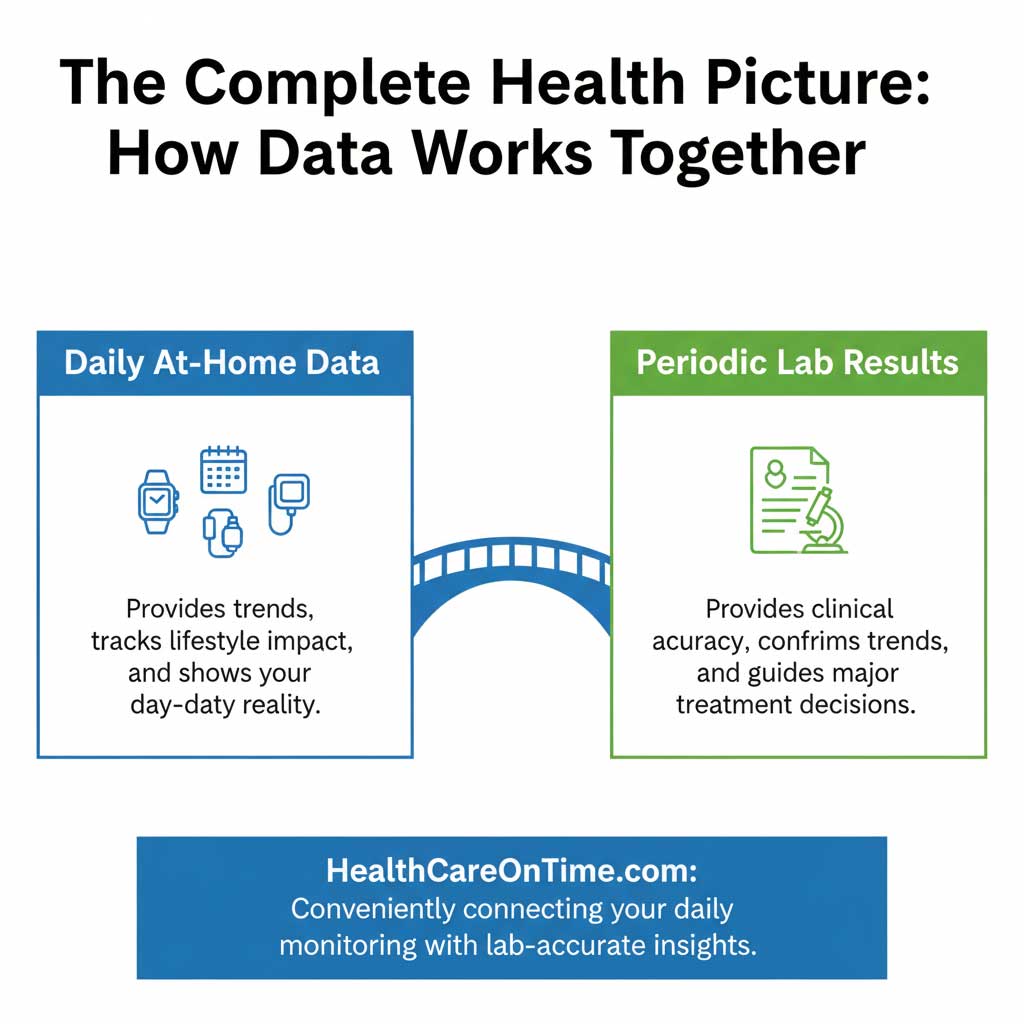
Convenient and Reliable Testing with HealthCareOnTime.com
HealthCareOnTime.com offers a simple, reliable, and convenient solution for getting these crucial lab tests done without the stress and inconvenience of visiting a collection center. By providing free home sample collection, we ensure that everyone, including those with mobility challenges or busy schedules, can access the diagnostic services they need for effective chronic disease monitoring.

Specialized Chronic Disease Management Packages
To further simplify the process, HealthCareOnTime.com offers curated testing packages specifically designed for managing chronic diseases.
- The Comprehensive Diabetes Care Panel includes essential tests like HbA1c (which shows your average blood sugar over three months), a lipid profile for cholesterol, and kidney function tests to monitor for complications.
- The Heart Health Monitoring Package provides a detailed analysis of your cardiovascular health, including tests for cholesterol, triglycerides, and C-reactive protein (a marker for inflammation).
By using these targeted packages, you and your doctor receive the precise clinical data needed to validate the information from your daily monitoring and make the most informed decisions for your long-term health.
The Big Picture: Healthcare System Impact and Provider Roles
Effective chronic disease monitoring does more than just benefit individual patients; it has a profound positive impact on the entire healthcare system and redefines the roles of healthcare providers.
Your Primary Care Physician: The Quarterback of Your Care Team

In modern chronic care management, your primary care physician (PCP) acts as the quarterback of your health team. They are the central hub for all your health information. Your PCP is responsible for interpreting the data from your in-clinic visits, your RPM devices, your lab tests from services like HealthCareOnTime.com, and your self-reported symptoms. They use this complete picture to adjust your medications, coordinate care with specialists, and guide you toward a healthier lifestyle.
How Monitoring Helps Reduce Healthcare Costs
The financial benefits of proactive monitoring are substantial. As mentioned earlier, chronic diseases are the leading driver of healthcare spending in the U.S. By preventing just one emergency room visit or one hospital stay, a chronic disease monitoring program can save thousands of dollars per patient. A study published in the Journal of Medical Economics confirmed that RPM programs can significantly reduce healthcare costs by enabling early interventions and preventing the progression of disease to more acute, expensive stages.
Navigating Insurance: Understanding Medicare Coverage for RPM
Recognizing the immense value of this proactive approach, the U.S. healthcare system is increasingly incentivizing its use. A common question from patients is about insurance coverage. The answer is overwhelmingly positive: Yes, Medicare Part B covers Chronic Care Management (CCM) and Remote Patient Monitoring (RPM) services. This landmark Medicare coverage for RPM has made these advanced monitoring technologies accessible to millions of seniors, who are often the most vulnerable to the complications of chronic illness.
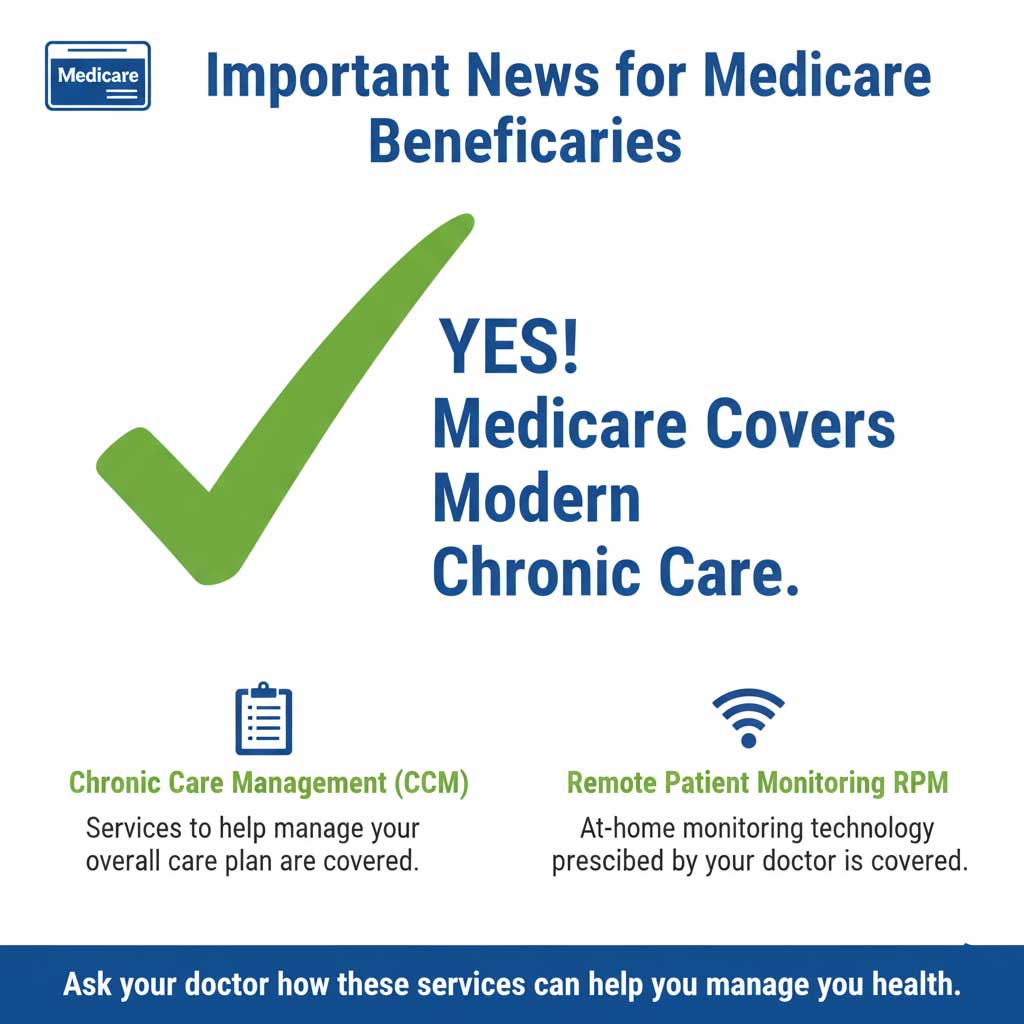
The Future of Chronic Disease Monitoring
The field of chronic disease monitoring is continuously evolving, driven by incredible advancements in technology. The future promises an even more personalized, predictive, and integrated approach to care.
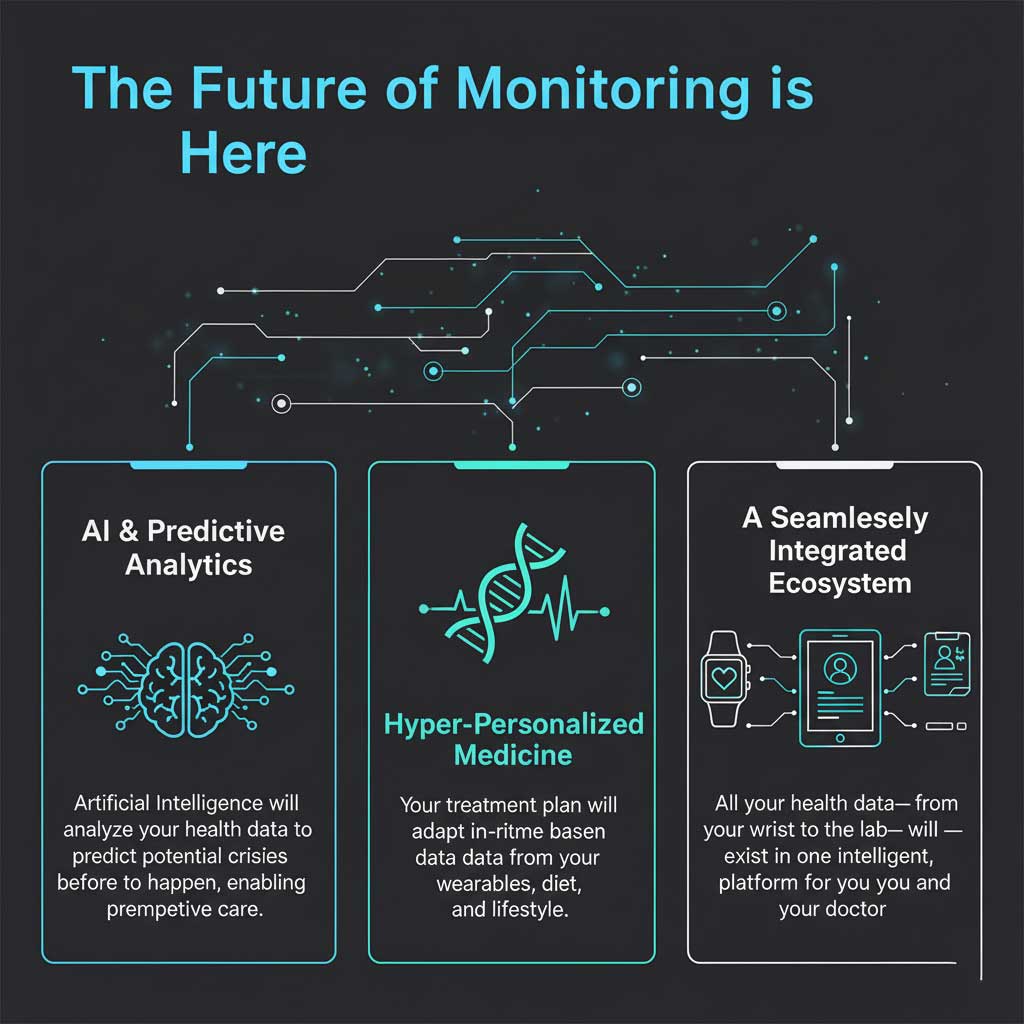
Artificial intelligence (AI) and machine learning algorithms are now being developed to analyze the vast datasets collected from wearable health devices and RPM platforms. These intelligent systems will be able to identify patterns and predict potential health crises—like a heart failure event or a severe hyperglycemic episode—days or even weeks before they occur, allowing for preemptive intervention. This shift toward predictive analytics will make managing chronic diseases more proactive than ever before.
| Chronic Disease | In-Clinic Monitoring | At-Home Self-Monitoring | Remote Patient Monitoring (RPM) | Key Metrics Tracked |
| Type 2 Diabetes | Quarterly HbA1c tests, annual foot & eye exams, lipid panels. | Daily finger-prick blood glucose checks, carb counting, symptom logging. | Continuous Glucose Monitors (CGM) sending real-time data to an app/provider. | Blood Glucose, HbA1c, Ketones, Medication Adherence. |
| Hypertension | Bi-annual or quarterly blood pressure checks in-office, EKG. | Daily blood pressure and heart rate readings using an automated cuff. | Bluetooth-enabled blood pressure cuffs that automatically sync readings to a provider’s dashboard. | Systolic & Diastolic Blood Pressure, Heart Rate. |
| Heart Failure | Regular physical exams, echocardiograms, blood tests (BNP levels). | Daily weight measurement, tracking for edema (swelling), shortness of breath, fatigue. | Smart scales, Bluetooth BP cuffs, and pulse oximeters that transmit data daily. | Weight, Blood Pressure, Heart Rate, Oxygen Saturation. |
| COPD | Pulmonary function tests, chest X-rays, arterial blood gas tests. | Tracking symptoms like coughing and wheezing, monitoring oxygen levels with a pulse oximeter. | Smart pulse oximeters and digital spirometers that send data for trend analysis. | Oxygen Saturation (SpO2), Respiratory Rate, Symptom Severity. |
Taking Control of Your Health Journey
Ultimately, chronic disease monitoring is about empowerment. It is a multi-faceted, collaborative strategy that combines clinical oversight from your doctor, consistent self-management at home, and the powerful capabilities of modern technology. This integrated approach is the key to successfully managing chronic diseases in the 21st century. It allows you to move from being a passive recipient of care to an active, informed leader of your own health team.
By embracing monitoring, you can improve your health outcomes, enhance your quality of life, and help reduce healthcare costs for everyone. Don’t wait for a health crisis to take action. Take a proactive step in managing your health today. Discuss a comprehensive monitoring plan with your doctor and explore convenient diagnostic testing options at HealthCareOnTime.com to get a clear and complete picture of your health.

